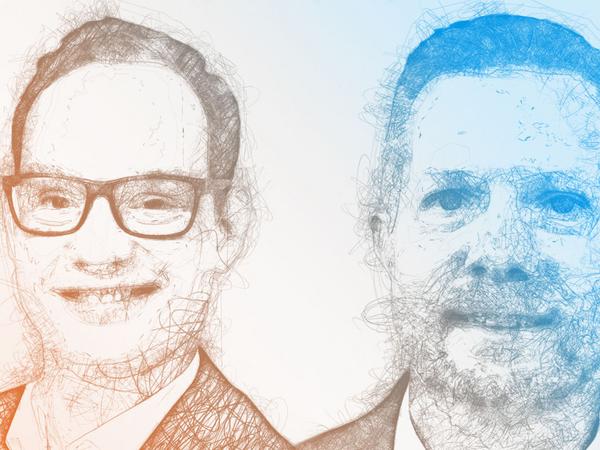Combining IT know-how with transformation skills

tts has been active in the HR consulting business for many years. What prompted you to add tts Transformation Consulting to the mix?
Roman Kropp: Consulting at tts has so far mainly focused on the technical implementation of digitalization projects in human resources. This involves things like helping customers reliably map out the entire employment life cycle from recruitment through to leaving the company.
However, the all-important groundwork for a successful transformation project is done much earlier. The problem is that IT often plays virtually no role at this early stage, which is why many projects fall short of the set goals or even fail. For instance, you can find out further down the line that the IT system does not fit the HR processes or the organization because it has been underestimated how closely interlinked these issues are. To avoid such squandered investments in the first place, a broader consulting approach is required that combines IT know-how with transformation skills. This enables the HR department to design governance, organization and processes in accordance with IT scenarios. This is the only way to make it fit for the future – and that’s exactly what we do at tts Transformation Consulting.
Dr. Stephan Schmid
Nowadays, every transformation project must also be thought of in terms of IT – in other words, as part of a holistic approach.
Does that mean the traditional approach of “IT follows function” is dead?
Stephan Schmid: Yes, reorganizing an HR department and its processes from scratch and subsequently adapting IT to these plans simply doesn’t work. Nowadays, every transformation project must also be thought of in terms of IT – in other words, as part of a holistic approach. This requires strong digital skills when it comes to cloud computing, implementation and operations. You also need people with specialist HR expertise who can bring new ideas to the table and take advantage of the digital opportunities available. What other consulting firm can combine these skills as effectively as we do? With all the skills we have on hand at tts, we’re always able to put together teams that perfectly suit the customer and their specific challenges by ensuring our core team has the necessary expertise.
What are the typical problems facing customers who turn to you?
Roman Kropp: Many have had an unsuccessful HR transformation project or have not realized their desired potential. This is usually because the customer envisioned an end goal without giving enough thought to IT, meaning the IT infrastructure now has to be hammered into shape somehow – which is very complex or, particularly in the case of cloud solutions, only possible to a limited extent. Others have opted for a state-of-the-art IT solution but haven’t adapted their HR business model to it. Then, shortly before the roll-out, they realize they’re headed for disaster because they lack the foundation necessary for the transformation.
And that’s when you come and fix it?
Roman Kropp: Yes, that too, but our main role isn’t to step in and fix things. What we aim to do is advise our customers so nothing needs to be fixed in the first place.
Stephan Schmid: You see, many companies are open to disruption on a technical level, but are quite conservative when it comes to culture, skills and structures. This often leads to deep-seated problems.
Dr. Stephan Schmid
For example?
Stephan Schmid: Take for example an SME that has evolved into a global player with strong national companies in Europe, Asia and America. You cannot simply introduce an HR cloud solution here, and then somehow straighten everything else out with a few adjustments later on. Instead, you first need to determine what degree of freedom these national companies should retain throughout the HR digitalization process and whether the new desired outcome can even be mapped with a standardized cloud solution. In this case, if you roll out a system without first creating the necessary governance requirements, the project is doomed to fail. This is because separate national companies tend to take divergent approaches and work with shadow solutions, thus shattering the dream of harmonized processes.
This is where we can help, because we have the experience and models necessary to build a sustainable governance and organizational structure – one that is comprehensive enough to allow for interaction between global, regional and local HR levels as well as between HR and IT, and to ensure the customer can derive the greatest possible added value from this organizational and technical transformation.
Roman Kropp
Our consulting services don’t end with a 50-page PowerPoint presentation, but rather with a successful roll-out.
Roman Kropp
What role do products like SAP SuccessFactors play in your consulting approach?
Roman Kropp: Our approach focuses more on solutions than on products. We look at what the company needs to survive in the digital world and how its Human Resources department has to be set up to meet these challenges. We answer questions such as: Where can innovative technologies deliver savings on administrative outlay and where can consulting support for business and activities such as active sourcing be expanded? How can an HR department focused on separate responsibilities be transformed into a customer-centric one?
The fact we have solution-supporting products at tts makes us an even more competent partner, as we can provide end-to-end support for HR transformations. Our consulting services don’t end with a 50-page PowerPoint presentation, but rather with a successful roll-out. And this can mean HR employees competently fulfilling their new role or a new, fully functioning IT landscape.
What do you think are the key challenges involved in HR transformation?
Stephan Schmid: The HR infrastructure needs to fit the company. When a traditionally structured company is switching over to a data-based business model, then the HR department is also expected to generate knowledge from data. This means, for example, identifying the relationship between employee turnover and the quality of leadership, or between employee commitment and customer satisfaction. When a company is undergoing a transformation, HR is expected to help shape this process without bringing day-to-day operations to a halt. To do this, the department’s own function must be rethought in many aspects. This is becoming an increasingly vital step.
Roman Kropp: The biggest challenge for me is managing the loss of control in an orderly manner – because that is the price every company has to pay for increased agility. Issues such as ambidexterity, decentralization, self-organization or mass customization play a role here, too. It’s a question of how much freedom really makes sense in certain parts of the company. First and foremost, however, it is about establishing a form of decentralized cooperation that, instead of producing a supposedly agile kind of pandemonium, promotes efficient coordination and decision-making processes within and between the communities that are increasingly shaping and further developing many functional areas of HR. Striking the necessary balance between “freedom” and “framework” and providing the required technical support for this will present a special challenge and opportunity for us and our customers in the coming years. And we’re more than ready to take it on.




